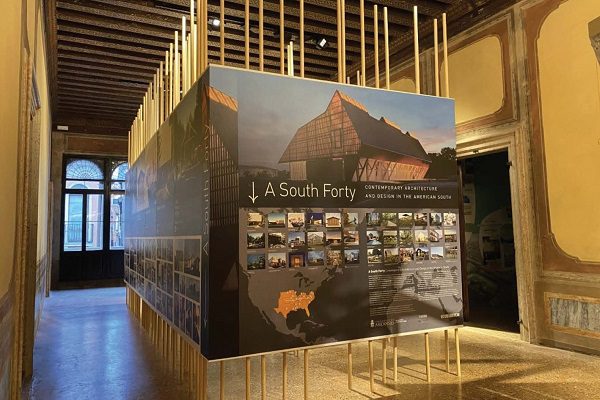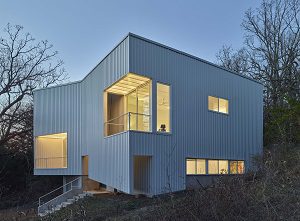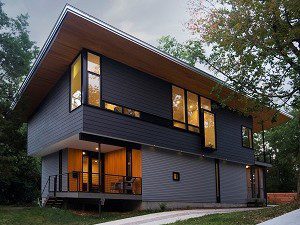Architecture Professor, Alumni Represented in Venetian Exhibition

A SOUTH FORTY: Contemporary Architecture and Design in the American South, an exhibition presented by The European Cultural Center in conjunction with the 2021 Venice Architecture Biennale, includes design projects by Associate Professor of Architecture Marc Manack’s firm, SILO AR+D, and The Raleigh Architecture Company, a practice co-founded by alumni Robby Johnston ‘03 and Craig Kerins ‘04. Organized by the Fay Jones School of Architecture and Design at the University of Arkansas with modus studio and Oxford American journal, the exhibition opened on May 22 and is on view in the Palazzo Mora in Venice, Italy, through November 21.
Geographically delineated by U.S. Highway 40, from North Carolina to Oklahoma, A SOUTH FORTY “aims to provide an overview of the current vitality of contemporary architecture and design in the American South, through both illustrated profiles of buildings and practices, and statements of principles and observations by those in practice in the region,” states the press release. The exhibition focuses on work created since 1990, covering a 30-year period in which the American South has experienced dramatic population growth and diversification and the onslaught of a range of natural disasters.
Manack is the founding principal of SILO AR+D (SILO Architecture, Research + Design), a practice he co-directs with Frank Jacobus. In 2016 SILO was selected as an “Emerging Voice” by the Architectural League of New York, in a prestigious competition that recognizes significant bodies of realized work and considers accomplishments within the design and academic communities. In 2018, SILO was recognized as a “Next Progessive” by Architect Magazine. SILO operates out of both Charlotte and Fayetteville, Arkansas. See their exhibition board here.
 “Our sensibility emerges out of where we work: in the middle of the United States, the ‘average’ part. We haven’t had the luxury of luxury, but we refuse to over‐romanticize our regionalism or use it as a crutch: we instead embrace it as work ethic,” Manack and Jacobus wrote in their exhibition contribution. “Architecture is a social act that can construct diverse audiences through diverse appearances. As such, our work is preoccupied with exploring the fundamentals of architectural presence through the effects of appearance, reappearance, and disappearance. Our aim is toward an architecture that is qualitatively‐rich, with vividly distinct characters that are revealed from changes in time, occupation, and event. We view the act of becoming visible as a form of theatre, a performance born of energy harnessed from collaborative authorship with public and place.”
“Our sensibility emerges out of where we work: in the middle of the United States, the ‘average’ part. We haven’t had the luxury of luxury, but we refuse to over‐romanticize our regionalism or use it as a crutch: we instead embrace it as work ethic,” Manack and Jacobus wrote in their exhibition contribution. “Architecture is a social act that can construct diverse audiences through diverse appearances. As such, our work is preoccupied with exploring the fundamentals of architectural presence through the effects of appearance, reappearance, and disappearance. Our aim is toward an architecture that is qualitatively‐rich, with vividly distinct characters that are revealed from changes in time, occupation, and event. We view the act of becoming visible as a form of theatre, a performance born of energy harnessed from collaborative authorship with public and place.”
Johnston and Kerins founded The Raleigh Architecture Company and its companion, The Raleigh Construction Company, in 2012. The firm has received multiple American Institute of Architecture (AIA) Regional Design Honor and Merit Awards, AIA NC Design Honor and Merit Awards, and Triangle Design Honor, Merit, and Homes Tour Awards for their single-family and multi-family residential housing. Together, Johnston and Kerins received the 2021 College of Arts + Architecture Distinguished Alumni Award in Architecture. See their exhibition board here.
 “As architects and builders, we engage in a constant collaboration to generate critical architectural responses specific to site, client, and budgetary means,” they wrote in their contribution to A SOUTH FORTY. “Our names reflect a commitment to our evolving, exciting city and a desire to participate in the modernist design legacy of the immediate and regional American South. Our office and workshop are maintained under one roof in Raleigh’s downtown warehouse district. Designing from here and building on locale, our practice has completed a diverse range of project typologies and scales necessary to accommodate the holistic needs of a flourishing city and region.”
“As architects and builders, we engage in a constant collaboration to generate critical architectural responses specific to site, client, and budgetary means,” they wrote in their contribution to A SOUTH FORTY. “Our names reflect a commitment to our evolving, exciting city and a desire to participate in the modernist design legacy of the immediate and regional American South. Our office and workshop are maintained under one roof in Raleigh’s downtown warehouse district. Designing from here and building on locale, our practice has completed a diverse range of project typologies and scales necessary to accommodate the holistic needs of a flourishing city and region.”